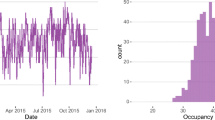Abstract
The number of no-shows has a significant impact on the revenue, cost and resource utilization for almost all healthcare systems. In this study we develop a hybrid probabilistic model based on logistic regression and empirical Bayesian inference to predict the probability of no-shows in real time using both general patient social and demographic information and individual clinical appointments attendance records. The model also considers the effect of appointment date and clinic type. The effectiveness of the proposed approach is validated based on a patient dataset from a VA medical center. Such an accurate prediction model can be used to enable a precise selective overbooking strategy to reduce the negative effect of no-shows and to fill appointment slots while maintaining short wait times.









Similar content being viewed by others
References
Barron WM (1980) Failed appointments: who misses them, why they are missed, and what can be done. Prim Care 7(4):563–574
Bean AG, Talaga J (1995) Predicting appointment breaking. J Health Care Mark 15(1):29–34
Bech M (2005) The economics of non-attendance and the expected effect of charging a fine on non-attendees. Health Policy 74(2):181–191
Bolstad WM (2007) Introduction to Bayesian statistics. Wiley-Interscience, New York
Brockwell P, Davis RA (2009) Time series: theory and methods. Springer Series in Statistics
Campbell JD, Chez RA, Queen TBA, Patron E (2000) The no-show rate in a high-risk obstetric clinic. J Women’s Health Gend-Based Med 9(8):891–895
Cashman SB, Savageau JA, Savageau L, Celeste A, Ferguson W (2004) Patient health status and appointment keeping in an urban community health center. J Health Care Poor Underserved 15:474–488
Cayirli T, Veral E (2003) Outpatient scheduling in health care: a review of the literature. Prod Oper Manag 12(4):519–549
Chakraborty S, Muthuraman K, Mark L (2010) Sequential clinical scheduling with patient no-shows and general service time distributions. IIE Trans 42(5):354–366
Cote MJ (1999) Patient flow and resource utilization in an outpatient clinic. Socio-Econ Plann Sci 33:231–245
Cynthia TR, Nancy HG, Scott C, Donna SJ, Wilcox WD, Adolesc AP (1995) Patient appointment failures in pediatric resident continuity clinics. Pediatr Adolesc Med 149(6):693–695
Dove HG, Karen CS (1981) The usefulness of patients’ individual characteristics in predicting no-shows in outpatient clinics. Med Care XIX(7):734–740
Dreihera J, Froimovicia M, Bibia Y, Vardya DA, Cicurela A, Cohen AD (2008) Nonattendance in obstetrics and gynecology patients. Gynecol Obstet Investig 66:40–43
Evans M, Hastings N, Peacock B (2000) Statistical distributions, 3rd edn. Wiley-Interscience, New York
Garuda SR, Javalgi RG, Talluri VS (1998) Tackling no-show behavior: a market driven approach. Health Mark Q 15(4):25–44
Glowacka KJ, Henry RM, May JH (2009) A hybrid data mining/simulation approach for modelling outpatient no-shows in clinic scheduling. J Oper Res Soc 60:1056–1068
Goldman L, Freidin R, Cook EF, Eigner J, Grich P (1982) A multivariate approach to the prediction of no-show behavior in a primary care center. Arch Intern Med 142:563–567
Gupta D, Denton B (2008) Appointment scheduling in health care: challenges and opportunities. IIE Trans 40:800–819
Hassin R, Mendel S (2008) Scheduling arrivals to queues: a single-server model with no-shows. Manage Sci 54(3):565–572
Haupt RL, Ellen S (2004) Practical genetic algorithm, 2nd edn. Wiley, New York
Hilbe JM (2009) Logistic regression models. Chapman & Hall/CRC Press
Hixon AL, Chapman RW, Nuovo J (1999) Failure to keep clinic appointments: implications for residency education and productivity. Fam Med 31(9):627–630
Ho C, Lau H (1992) Minimizing total cost in scheduling outpatient appointments. Manag Sci 38(2):1750–1764
Kleinbaum DG, Klein M (2002) Logistic regression a self-learning text, 2nd edn. Springer, New York
LaGanga LR, Lawrence SR (2007) Clinic overbooking to improve patient access and increase provider productivity. Decis Sci 38:251–276
Lehmann TNO, Aebia A, Lehmann D, Balandraux OM, Stalder H (2007) Missed appointments at a Swiss university outpatient clinic. Public Health 121(10):790–799
Liu N, Ziya S, Kulkarni VG (2009) Dynamic scheduling of outpatient appointments under patient no-shows and cancellations. Manuf Serv Oper Manag 12:347–364
Moore CG, Wilson-Witherspoon P, Probst JC (2001) Time and money: effects of no-shows at a family practice residency clinic. Fam Med 33(7):522–527
Muthuraman M, Lawley M, (2008) A stochastic overbooking model for outpatient clinical scheduling with no-shows I. 40(9):820–837
Nadkarni MM, Philbrick JT (2005) Free clinics: a national study. Am J Med Sci 330(1):25–31
Rust CT, Gallups NH, Clark S, Jones DS, Wilcox WD, Adolesc A (1995) Patient appointment failures in pediatric resident continuity clinics. Pediatr Adolesc Med 149(6):693–695
Simonoff JS (1996) Smoothing methods in statistics, Springer Series in Statistics. Springer, New York
Wang J (2009) Encyclopedia of data warehousing and mining, 2nd edn. Information Science Reference, Hershey
Bo Z, Turkcan A, Lin J (2010) Clinic scheduling models with overbooking for patients with heterogeneous no-show probabilities. Ann Oper Res 178(1):121–144
Author information
Authors and Affiliations
Corresponding author
Appendix - Gaussian Mixture Models (GMM) and Expectation Maximization (EM) Algorithm
Appendix - Gaussian Mixture Models (GMM) and Expectation Maximization (EM) Algorithm
Gaussian Mixture Models (GMM) assume data points are drawn from a distribution that can be approximated by a mixture of Gaussian distributions. In this regard, assuming Q, the no-show rate of each clinic, is the feature vector, and k is the number of components (clinic clusters), the mixture model can be rewritten as:
Where \( \left\{ {{a_1},...,{a_k},{\theta_1},...,{\theta_k}} \right\} \) is the collection of parameters with \( 0 \leqslant {a_i} \leqslant 1,\forall i = 1,2,...,k \) and \( \sum\nolimits_{{i = 1}}^k {{a_i} = 1} \) and \( p\left( {Q|{\theta_i}} \right) = \frac{1}{{\sigma \sqrt {{2\pi }} }}\exp \left( { - \frac{{Q - {\mu_i}}}{{2\sigma_i^2}}} \right) \). Having as a set of n, i.i.d samples \( Q = \left\{ {{q^{{(1)}}},{q^{{(2)}}},...,{q^{{(n)}}}} \right\} \) from the above model the log-likelihood function can be rewritten as:
Here, the goal is to find Θ that maximizes the log-likelihood function:
The surface of the above likelihood function is highly nonlinear, and no closed form solution exists for the above likelihood function. One way to deal with this problem is by introducing a hidden variable Z:
and using Expectation Maximization (EM) algorithm as follows [33]:
-
i.
Initializing parameters Θ
-
ii.
Iterating the following until convergence:
Rights and permissions
About this article
Cite this article
Alaeddini, A., Yang, K., Reddy, C. et al. A probabilistic model for predicting the probability of no-show in hospital appointments. Health Care Manag Sci 14, 146–157 (2011). https://doi.org/10.1007/s10729-011-9148-9
Received:
Accepted:
Published:
Issue Date:
DOI: https://doi.org/10.1007/s10729-011-9148-9




